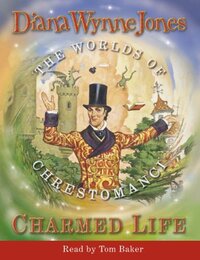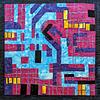Take a photo of a barcode or cover
Stories of learning magic have become commonplace these days: I've even heard Diana Wynne Jones dismissed unfairly as a ripoff of JK Rowling when Diana Wynne Jones came first. There's nothing commonplace about Charmed Life: this is a fantastic story about a boy, Cat, who lives with a very ambitious witch sister after their parents drown. He goes to live with an impressively powerful man, Chrestomanci, and becomes involved in a strange political war between those who want to use magic without regard to the consequences for ordinary folks and those who want to keep magic somewhat under control. Cat is a charmingly unassuming narrator who is aware of his own inferiority--he can't even work the charm to turn buttons into gold--but caught up in something much bigger than he is. I think I've read this novel several times and still found myself laughing and commiserating with Cat every time.
This is one of the gold standards I judge children's fantasy by: it's a world of magic with true character and unique plays of ideas, particularly in the concept of a "nine lived enchanter" and a brilliant use of alternate universes that manages to feel comfortable and appropriate rather than forced and contrived.
This is one of the gold standards I judge children's fantasy by: it's a world of magic with true character and unique plays of ideas, particularly in the concept of a "nine lived enchanter" and a brilliant use of alternate universes that manages to feel comfortable and appropriate rather than forced and contrived.
A fun read, how can Cat & Janet dig themselves any deeper into trouble while trying so desperately to get themselves out? Appealing characters except for Gwendolyn and her evil cronies.
This was a re-read from pre Goodreads times. I am a big Jones fan & went through all I could find in the late 80's, early 90's.
This was a re-read from pre Goodreads times. I am a big Jones fan & went through all I could find in the late 80's, early 90's.
adventurous
funny
mysterious
fast-paced
Plot or Character Driven:
A mix
Strong character development:
Complicated
Loveable characters:
Yes
Diverse cast of characters:
No
Flaws of characters a main focus:
No
Good kids book. I wanted to like it as an adult, because I like a lot of children's fantasy, the rhythmic storytelling, but the phrasing bounced between unusual (in an interesting way) and boring. I felt the magic wasn't explained enough for a first book, and the characters seemed hard to comprehend motive-wise.
This book is so flipping delightful. I’m surprised that it doesn’t have more of a following, though I’m starting to think that it might have an underground following.
Charmed Life is magical and whimsical, with a beautiful main character who is flawed but so relatable. The magic is as welcoming as that of Harry Potter and the story kept me engaged until the very last moment. It’s one of those children’s stories that doesn’t talk down to kids and so remembering my first read of this book many moons ago I still love this book.
Charmed Life is magical and whimsical, with a beautiful main character who is flawed but so relatable. The magic is as welcoming as that of Harry Potter and the story kept me engaged until the very last moment. It’s one of those children’s stories that doesn’t talk down to kids and so remembering my first read of this book many moons ago I still love this book.
The provinces of Britain have a way of creating magical children's writers, and Diana Wynn Jones is one of Wales' finest. If you read (or watched) and loved Howl's Moving Castle you will most likely enjoy this too, the first of the Chrestomanci series.
It follows the fortunes of two orphaned children, the sister magically gifted while her brother is not. When Gwendolyn outgrows the magical training available in her backwater home town, she is at first delighted at the chance to study under the great Chrestomanci. But she hasn't reckoned with the household's ability to handle her magical genius, and finds herself frustrated. Only her brother Cat realises how ruthlessly ambitious she is; and even he underestimates how far she is prepared to go to have her own way.
Diana creates very authentic child characters, but the story is very much one about in-loco-parentis tolerance and boundary setting. Cat holds the narrator's point of view, watching passively from the sidelines, trying to make the right decisions but not always succeeding as Gwendolyn dominates both the storyline and him. Unlike the children in many other stories (Roald Dahl, J K Rowling, C S Lewis), these are not the smart, sensible kids who have to put up with grown-ups acting foolishly, but adolescents who, out of overconfidence or self-doubt, make some serious mistakes. It's a cautionary, even scary, tale of understanding the consequences of both your actions and your inactions. There are selfish, stupid adults too: but the Chrestomanci grown-ups represent the patient, forbearing and loving adults who are prepared to let the children learn from their mistakes despite the disruption, with punishment as a consequence only when they blindly choose not to learn.
There are two key twists in the plot, one predictable and one not, which set us and the main characters up for the rest of the series. Several of the characters are not very developed yet, so I look forward to reading further into the series to see how they change.
It follows the fortunes of two orphaned children, the sister magically gifted while her brother is not. When Gwendolyn outgrows the magical training available in her backwater home town, she is at first delighted at the chance to study under the great Chrestomanci. But she hasn't reckoned with the household's ability to handle her magical genius, and finds herself frustrated. Only her brother Cat realises how ruthlessly ambitious she is; and even he underestimates how far she is prepared to go to have her own way.
Diana creates very authentic child characters, but the story is very much one about in-loco-parentis tolerance and boundary setting. Cat holds the narrator's point of view, watching passively from the sidelines, trying to make the right decisions but not always succeeding as Gwendolyn dominates both the storyline and him. Unlike the children in many other stories (Roald Dahl, J K Rowling, C S Lewis), these are not the smart, sensible kids who have to put up with grown-ups acting foolishly, but adolescents who, out of overconfidence or self-doubt, make some serious mistakes. It's a cautionary, even scary, tale of understanding the consequences of both your actions and your inactions. There are selfish, stupid adults too: but the Chrestomanci grown-ups represent the patient, forbearing and loving adults who are prepared to let the children learn from their mistakes despite the disruption, with punishment as a consequence only when they blindly choose not to learn.
There are two key twists in the plot, one predictable and one not, which set us and the main characters up for the rest of the series. Several of the characters are not very developed yet, so I look forward to reading further into the series to see how they change.
The ages of the characters seem to shift, and the ending is way too easily wrapped up. What I love about it is the introduction to Chrestomanci, whom we meet as an adult in The Lives of Christopher Chant.
I wish I had found this book as a child. I would have loved it so much, given that it is a bit darker fare than typical for children's tales.
Alas, it was not to be. As it stands, the blind loyalty and mystery by keeping secrets chafed at my adult sensibilities. I still appreciated how very dark the story went and found the interesting.
Alas, it was not to be. As it stands, the blind loyalty and mystery by keeping secrets chafed at my adult sensibilities. I still appreciated how very dark the story went and found the



